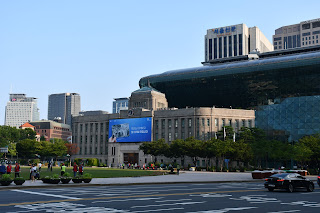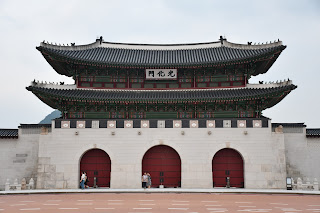The De-Militarised Zone
On our
penultimate day in Seoul, my dad and I made a trip to the De-Militarised Zone.
As one may perhaps expect, it is not a journey one person, whether foreign or Korean, can make by
themselves. There are only a few companies that are licensed to lead tours to
the DMZ, and even fewer that can lead tours to the Joint Security Area (JSA).
We, therefore, joined a half-Japanese, half-English-speaking tour bus in the
centre of the city, and let ourselves be led around the sights to be seen.
Seoul City Hall - the bus set off for the DMZ close-by
"I Seoul U"
The
De-Militarised Zone is a four-kilometre-wide strip of land around the demarcation
line established at the end of the Korean War. As the name indicates, the DMZ
is an area free of weapons, though Koreans joke that surrounding it is the TMZ,
the “Totally Militarised Zone,” where hundreds of thousands of soldiers stand
in constant readiness for conflict. Strangely enough, the DMZ has become a
popular tourist destination, with busloads of visitors arriving every day –
some even from the north – to peer across the border.
The view of South Korean guard towers and North Korean mountains from the bus
Appropriately,
our first stop was the new Dora Observatory, a modern building with huge glass
windows and roof-top telescopes perfectly suited to give tourists the best view
of North Korea. From the building, one can clearly see fences and guard posts, as
well as two giant flagpoles, one South Korean and one North Korean, facing each
other off on opposite sides of the border. It was a surreal experience.
Barbed wire and cross
People peering into North Korea
A café with a view of North Korea
The DMZ: the flags of South Korea and North Korea, and Kaesong farther back
A South Korean guard tower
Binoculars into North Korea
The original Dora Observatory
Equally
surreal was our visit to the Dorasan railway station, another hyper-modern
building but much less useful and much more puzzling. Once a simple station on
the route from Seoul to Pyongyang, Dorasan Station now houses bizarre, wishful
maps of a Trans-Eurasian railway beginning in Seoul, running through North
Korea, and ending all the way in Lisbon. Admittedly, it does still serve as a
train station, but only receives tourist trains coming from the south.
Dorasan Station
A map of the Trans-Eurasian Rail Network
Rail tracks
Somewhat optimistic signboards
The bus
transported us to yet another site, this time the so-called “Third Tunnel of
Aggression.” North Korea began to build this tunnel in the 1970s as part of an
effort to launch a surprise attack on its southern neighbour, yet it gave
itself away in the June of 1978 with an underground explosion. While North
Korea subsequently claimed the tunnel was part of a coal mine, South Korea has
pointed to the general scarcity of coal in the area, and there are even claims
that the North Koreans painted a few rocks black to make them look like coal.
Sadly, during our visit, the weather was not on our side and the tunnel was
closed off for fear of flooding. We walked down a steep South Korean-built
tunnel to its entrance, and then clambered our way back up again.
After lunch
(I now consider the de-militarised variety the best kimchi I have ever eaten),
we visited a memorial with an old rusty train from the Korean War.
An old lady at the memorial
A Vietnam War era train
Thousands of messages attached to a fence
A war memorial
The final
part of our visit was the Joint Security Area, the place where the cease-fire
talks between the United Nations Command and the Korean People’s Army and
Chinese People’s Volunteers were held. To enter the JSA, we had to board a
special UN bus, leaving behind our South Korean tour guide (it is much more
difficult for South Koreans to visit the JSA, partly because of safety concerns
and partly for fear of defection). Instead of our tour guide, we were joined by
an American sergeant, a young man with a slightly unintelligible army-like slur
and a gallows sense of humour. He showed us the place where Kim Jong-un and
Moon Jae-in skipped across each other’s borders all smiles and holding hands, a
gesture that was soon repeated by Kim Jong-Un and Donald Trump. Of course, the
most anticipated part of the visit was crossing over to the North Korean side
inside one of the JSA conference rooms – something that all of us did perhaps a
little too willingly.
A soldier at the JSA
A soldier in front of the tree jointly planted by the leaders of North and South Korea
The tree planted by Kim Jong-un and Moon Jae-in
North Korean Panmungak Hall in the background
A South Korean soldier
Soldier in front of Panmungak
Our guide at the Northern side
The view of South Korea from the North
Freedom House
A JSA church
The JSA Buddhist shrine
Upon
returning to Seoul, I once again ate dinner with Michael. Sneakily upholding
Korean hospitality code, he paid for the meal while I was in the bathroom.
After making a short visit to the local adidas store to marvel at the extent of
Korean consumerism, Michael took me to see Yonsei University where he has been
studying this summer. Perhaps the most remarkable feature of this university is
how similar it is to Yale, both in its colours, the iconic Y, and the
occasional ivy-clad building. Michael had me taste milk soda and was
disappointed that I found it completely disgusting. Really it should not be
surprising considering it tastes nothing like milk.
Seoul Tower
Downtown Seoul
A church
Downtown Seoul
Admiral Yi, famous for repelling the Japanese invasions of 1592-8
Gyeongbokgung and King Sejong
Admiral Yi
A protestor
King Sejong and the Gyeongbokgung
King Sejong
Gyeongbokgung
Gwanghwamun
Haechi
The roof of Gwanghwamun
Gwanghwamun in the evening
A church near Yonsei
Seoul's streets at night
Ivy-clad Yonsei
Yonsei
Yonsei School of Theology
Park at Yonsei
Library at Yonsei
Michael Slav-squatting at the Adidas store
Michael once again at the Adidas store
Michael at the Adidas store with a more fitting hand gesture

























































Comments
Post a Comment